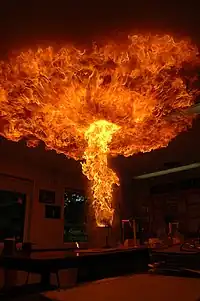A boilover (or boil-over) is an extremely hazardous situation in which a water layer under a pool fire (usually an open-top tank fire) starts boiling, which results in a significant increase in fire intensity accompanied by violent expulsion of burning fluid to the surrounding areas.[1][2]
Features
The extreme violence of boilovers is due to the expansion of water from liquid to steam, which is by a factor of about 1700. The presence of water under the burning fluid is sometimes due to spurious accumulation during plant operation (e.g., rainwater entering a seam in the tank roof, off-specification products from the source, residual water from an oil reservoir) or as a consequence of attempts to extinguish the fire with water.
Several mathematical models for boilover have been developed.[3][4][5] The models try to make sense, among other things, of the time necessary for boilover to initiate, which is determined by the burning rate of the liquid and the downwards velocity of a hot zone front moving from the fire surface to the fuel-water interface. Tank fires that appear to be relatively stable may burst into massive boilovers several hours after the fire starts, as it occurred in the Tacoa disaster. Like in the latter case, failure to appreciate the hazards posed by a water layer underneath the fuel has historically been the primary contributing cause to the aftermath of boilover accidents, in terms of human and/or material losses. Uncertainty surrounding the time to boilover onset adds unpredictability that further complicates the efforts of the firefighting services.
Pure chemical species are not liable to cause boilover. In order for one to occur, the material must be a mixture of species with different boiling points. Commercial hydrocarbon mixtures, such as gasoline, diesel oil, kerosene, etc., and crude oil are examples of such materials.[2] The fact that these are stored in large atmospheric tanks in refineries, tank farms, power stations, etc. makes boilover a hazard of interest in terms of process safety.[6][7]
Historical accidents that involved boilover occurred for example in Tacoa, Venezuela, in 1982 (the worst tank fire ever occurred worldwide) and Milford Haven, in 1983.
Related phenomena
Slopover and frothover are phenomena similar to boilover, although distinct from it.[1][2]
A slopover occurs when water is poured onto the fuel while a pool fire is occurring. If the fire is small enough, the water that instantly boils in contact with the fire or with the lower layers of blazing liquid (which are themselves not on fire but may be hotter than the water boiling point) can extend the flames, especially in the upwards direction.[2][3] Such slopovers are common at the domestic scale, for example in cooking fires. If the size of the fire is more important, such as in industrial-scale tank fires, there is no noticeable effect when water is doused on the fire. (However, water sinking to the bottom of the tank may contribute to a later boilover).

 Oil is heated strongly
Oil is heated strongly After some time, it gets hot enough to catch fire
After some time, it gets hot enough to catch fire Pouring a very small amount of water into the fire ejects a plume of fire
Pouring a very small amount of water into the fire ejects a plume of fire The plume rises and spreads against the ceiling
The plume rises and spreads against the ceiling
A frothover occurs when water is found under a layer of a viscous oil that is not on fire and whose temperature is higher than the water boiling point. An example is hot asphalt loaded into a tank car containing some water.[1][2]
See also
- Phreatic eruption, a similar concept in volcanic eruption.
References
- 1 2 3 NFPA (2003). Flammable and Combustible Liquids Code. NFPA 30. Quincy, Mass.: National Fire Protection Association.
[...] an event in the burning of certain oils in an open-top tank when, after a long period of quiescent burning, there is a sudden increase in fire intensity associated with expulsion of burning oil from the tank.
- 1 2 3 4 5 API (1991). Fighting Fires in and Around Flammable and Combustible Liquid Atmospheric Storage Tanks. API Publication 2021 (3rd ed.). Washington, D.C.: American Petroleum Institute. p. 29.
- 1 2 Garo, Jean-Pierre; Koseki, Hiroshi; Vantelon, Jean-Pierre (2007). "Combustion of Liquid Fuels Floating on Water" (PDF). Thermal Science. 11 (2): 119–140. doi:10.2298/TSCI0702119G. Retrieved 2008-11-09.
- ↑ Hristov, Jordan (2006). "An Inverse Stefan Problem Relevant to Boilover: Heat Balance Integral Solutions and Analysis". Thermal Science. 11 (2): 141–160. arXiv:1012.2534. doi:10.2298/TSCI0702141H.
- ↑ Ferrero, Fabio (2006). Incendios de hidrocarburos: estudio de la formación y evolución del boilover de capa fina [Hydrocarbon Fires: A Study on the Formation and Evolution of Thin Layer Boilover]. (PhD thesis) (in Spanish). Barcelona: Universitat Politècnica de Catalunya. ISBN 9788469346976. Archived from the original on 2017-03-09. Retrieved 2023-08-05.
- ↑ Biswas, Samarendra Kumar; Mathur, Umesh; Hazra, Swapan Kumar (2021). Fundamentals of Process Safety Engineering. Boca Raton, Fla., etc.: CRC Press. doi:10.1201/9781003107873. ISBN 9780367620769.
- ↑ Kletz, Trevor. Dispelling Chemical Engineering Myths (3rd ed.). Washington, D.C., etc.: Taylor & Francis. pp. 96–97. ISBN 1-56032-438-4.
Further reading
- INERIS (2015). Standard Boil-over and Thin Layer Boil-over (PDF). Omega 13 Report. Verneuil-en-Halatte: Institut national de l'environnement industriel et des risques. Retrieved 2023-07-20.
External links
 Media related to Chip-pan fires at Wikimedia Commons
Media related to Chip-pan fires at Wikimedia Commons